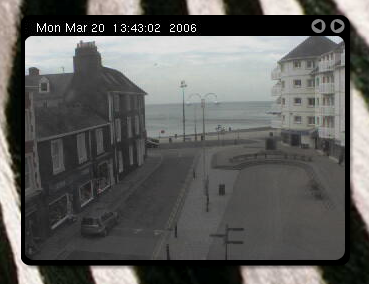There’s a reason that people shouldn’t show me new programming languages and development platforms: I try them out. Even when I’ve got other things I should be doing. Ah well.
And so I’d like to present: the Aberystwyth Webcams Widget [update: link dead], which collates the images of the three Ceredigion Country Council webcams into a little widget that sits on your desktop. It works in both Windows and MacOS X (on MacOS, it integrates quite nicely with any other desktop widgets you’re using), but you do need to install the Yahoo! Widget Engine version 2.0 or above.
Aberystwyth Webcams Widget (165KB) [update: link dead]
Never written a Yahoo! Widget before, so I’m interested in any feedback you care to leave.

Sounds interesting, but why would you want to install Yahoo’s widget thing on OS X when there is already the Dashboard?
Because Yahoo! Widgets supplements the Dashboard on OS X, not replaces it – with Yahoo! Widgets installed, OS X users are able to use not only Dashboard widgets in their Dashboard, but also Yahoo! Widgets: Yahoo! Widgets are platform-independent, and so different people are writing them.
Your question is like saying “Why buy a mobile when I already have a landline?” The two are for different purposes, and have different features and limitations. Right now, installing Yahoo! Widgets is the only way, as far as I know, to install an Aberystwyth Webcam Widget on your desktop (whether you’re using Windows or Mac OS), for example, so if you wanted one, you’d either have to install it or write another (both good options, but I’m sure you can see which one is easier).
what the hell is a widget?
restlessboy: A widget is a small utility program that sits on your desktop. Install the Yahoo! Widget Engine and you’ll soon understand. And then you can uninstall it if your answer satisfies your curiosity.
angel_hayles: Here’s an interesting comparison of the features of Dashboard versus Yahoo! Widgets (then called Konfabulator) -> http://www2.konfabulator.com/forums/index.php?showtopic=7630
I always thought “Widget” was a made up word, like thingie.
Learn something every day.
Got to agree with Hayley – I’m not going to install another widget engine when I already have Dashboard installed. There are some differences, too – Dashboard widgets live on their own layer ‘above’ the normal desktop. This means that they’re out of the way until I need them. Konfabulator^H^H^H^H^H^H^H^H^H^H^H^H, sorry, Yahoo widgets are persistent on the desktop in OSX, and they don’t play nicely with Expose (i.e, they expose their nature as ‘applications’ and hence appear as a task to switch to, rather than being desktop agumentation). I think the Dashboard behaviour is more sane. I’d rather keep apps (which I interact with), and widgets (which I usually just read) seperate.
I know that Dashboard widgets are a nice combination of XML and Javascript (or some scripting ‘ting, anyway), are Konfabulator widget? This file seems to have been compiled at some point. Assuming they’re both based on an XML/(insert some markup based language here) or whatever, could you use XSLT to kind of cross compile for both engines? It’s late, so I’m probably wrong.
–Jon
Aye; you’re right, it is just another widget engine. However:
1. Yahoo! Widgets also live in a layer above the normal desktop, exactly like Dashboard widgets. Except they also have the capability to act as windows, if the user so wishes. The default behaviour for newly-installed widgets is to behave like application windows, but a change is only three clicks away. So, in actual fact, Konfab widgets can work in the same way as Dashboard ones (albeit, somewhat annoyingly, on a *seperate*) “Dashboard” called the “Heads Up Display”, but they can *also*, on user request, work as the application window types you suggest.
2. Yes, Konfabulator widgets are also XML/Javascript. There have been proposed XSLTs to perform translations, but I (a) don’t have a Mac to try them out on and (b) don’t care – I wrote the tool as an excuse to play with a new development language, not to genuinely produce something useful (that was just a side-effect). The “compilation” of a Konfab widget is simply packaging it into a ZIP file, and this isn’t strictly necessary; just convenient. As a result, all Konfab widgets are open source by their nature.
I developed an RSS widget for a client a little while back, it’s really nice and intuitive to develop Konfabulator widgets, although doing any kind of serious programming in JavaScript sucks.